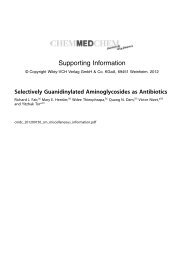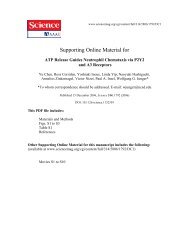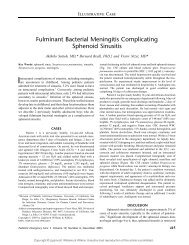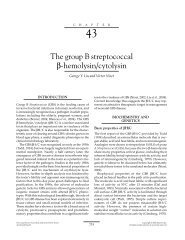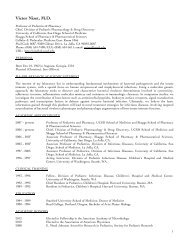BACTERIAL SEPSIS AND MENINGITIS - Nizet Laboratory at UCSD
BACTERIAL SEPSIS AND MENINGITIS - Nizet Laboratory at UCSD
BACTERIAL SEPSIS AND MENINGITIS - Nizet Laboratory at UCSD
Create successful ePaper yourself
Turn your PDF publications into a flip-book with our unique Google optimized e-Paper software.
In tropical areas, a different p<strong>at</strong>tern can be observed<br />
[289–291]. In Riyadh, Saudi Arabia, from 1980-1984,<br />
E. coli, Klebsiella species, and Serr<strong>at</strong>ia species were the<br />
dominant causes of neon<strong>at</strong>al sepsis; GBS was an infrequent<br />
cause [291]. L<strong>at</strong>er d<strong>at</strong>a from this geographic loc<strong>at</strong>ion<br />
revealed E. coli and CoNS were the most common<br />
p<strong>at</strong>hogens, however, causing early-onset and l<strong>at</strong>e-onset<br />
sepsis [292].<br />
Every year, 4 million neon<strong>at</strong>al de<strong>at</strong>hs occur. About one<br />
third of the de<strong>at</strong>hs are due to sepsis [293,294]. The highest<br />
numbers of neon<strong>at</strong>al de<strong>at</strong>hs are in South Central Asian<br />
countries and sub-Saharan Africa. The global perspective<br />
of neon<strong>at</strong>al sepsis is discussed in Chapter 2. The most<br />
common isol<strong>at</strong>es responsible for neon<strong>at</strong>al sepsis vary by<br />
country, but include a wide spectrum of gram-neg<strong>at</strong>ive<br />
and gram-positive species, the most common of which<br />
are E. coli, S. aureus, Pseudomonas, and Klebsiella [295].<br />
Multidrug-resistant strains are an increasing thre<strong>at</strong> to<br />
intervention programs [296,297].<br />
GBS is the most frequent cause of early-onset and l<strong>at</strong>eonset<br />
sepsis in the United St<strong>at</strong>es, but the r<strong>at</strong>es and risk<br />
factors for m<strong>at</strong>ernal and neon<strong>at</strong>al GBS coloniz<strong>at</strong>ion and<br />
disease vary in different communities [298–300]. Amin<br />
and colleagues [298] in the United Arab Emir<strong>at</strong>es evalu<strong>at</strong>ed<br />
563 pregnant women from similar socioeconomic<br />
and ethnic backgrounds and reported a GBS coloniz<strong>at</strong>ion<br />
r<strong>at</strong>e of 10.1%. In Athens, Greece, m<strong>at</strong>ernal and neon<strong>at</strong>al<br />
coloniz<strong>at</strong>ion r<strong>at</strong>es were 6.6% and 2.4% with a vertical<br />
transmission r<strong>at</strong>e of 22.5% [299]. Middle-class women<br />
followed in the priv<strong>at</strong>e setting were more frequently colonized<br />
with GBS than women followed in a public hospital.<br />
No associ<strong>at</strong>ion was found between coloniz<strong>at</strong>ion with<br />
GBS and m<strong>at</strong>ernal age, n<strong>at</strong>ionality, marital st<strong>at</strong>us, previous<br />
obstetric history, cesarean section, infant birth<br />
weight, or preterm birth.<br />
Stoll and Schuch<strong>at</strong> [300] reviewed d<strong>at</strong>a on female genital<br />
coloniz<strong>at</strong>ion with GBS from 34 reports in the liter<strong>at</strong>ure<br />
and emphasized the importance of appropri<strong>at</strong>e specimen<br />
collection and inocul<strong>at</strong>ion into selective (antibioticcontaining)<br />
broth media in the ascertainment of accur<strong>at</strong>e<br />
coloniz<strong>at</strong>ion r<strong>at</strong>es. Analysis of d<strong>at</strong>a from studies employing<br />
adequ<strong>at</strong>e methods revealed regional GBS coloniz<strong>at</strong>ion<br />
r<strong>at</strong>es of 12% in India and Pakistan, 19% in Asian and<br />
Pacific countries, 19% in sub-Saharan Africa, 22% in the<br />
Middle East and North Africa, and 14% in the Americas.<br />
A comparison of studies th<strong>at</strong> did and did not use selective<br />
broth media revealed significantly higher GBS coloniz<strong>at</strong>ion<br />
r<strong>at</strong>es in the popul<strong>at</strong>ions where selective broth media<br />
was employed to assess coloniz<strong>at</strong>ion. Other reasons for<br />
varying r<strong>at</strong>es of GBS coloniz<strong>at</strong>ion and disease may include<br />
socioeconomic factors or differences in sexual practices,<br />
hygiene, or nutrition.<br />
Socioeconomic Factors<br />
The lifestyle p<strong>at</strong>tern of mothers, including cultural practices,<br />
housing, nutrition, and level of income, seems to<br />
be important in determining infants <strong>at</strong> risk for infection.<br />
The most significant factors enhancing risk for neon<strong>at</strong>al<br />
sepsis are low birth weight and prem<strong>at</strong>urity, and the<br />
incidence of these is inversely rel<strong>at</strong>ed to socioeconomic<br />
st<strong>at</strong>us. Various criteria for determining socioeconomic<br />
CHAPTER 6 Bacterial Sepsis and Meningitis<br />
241<br />
st<strong>at</strong>us have been used, but no completely s<strong>at</strong>isfactory<br />
and reproducible standard is available. M<strong>at</strong>ernal educ<strong>at</strong>ion,<br />
resources, and access to health care can affect the<br />
risk of neon<strong>at</strong>al sepsis. A CDC report [301] evalu<strong>at</strong>ing<br />
the awareness of perin<strong>at</strong>al group B streptococcal infection<br />
among women of childbearing age in the United St<strong>at</strong>es<br />
revealed th<strong>at</strong> women with a high school educ<strong>at</strong>ion or less;<br />
women with a household income of less than $25,000;<br />
and women reporting black, Asian/Pacific Islander, or<br />
other ethnicity had lower awareness of perin<strong>at</strong>al GBS<br />
infections than other women.<br />
Procedures<br />
Most infants with very low birth weight have one or more<br />
procedures th<strong>at</strong> place them <strong>at</strong> risk for infection. Any disruption<br />
of the protective capability of the intact skin or<br />
mucosa can be associ<strong>at</strong>ed with infection. In a multicenter<br />
study of NICU p<strong>at</strong>ients, increased risk of bacteremia was<br />
associ<strong>at</strong>ed with parenteral nutrition, mechanical ventil<strong>at</strong>ion,<br />
peripherally inserted central c<strong>at</strong>heters, peripheral<br />
venous c<strong>at</strong>heters, and umbilical artery c<strong>at</strong>heters [302].<br />
NURSERY OUTBREAKS OR EPIDEMICS<br />
The nursery is a small community of highly susceptible<br />
infants where p<strong>at</strong>ients have contact with many adults,<br />
including parents, physicians, nurses, respir<strong>at</strong>ory therapists,<br />
and diagnostic imaging technicians (see Chapter 35).<br />
Siblings may enter the nursery or mothers’ hospital suites<br />
and represent an additional source of infection. In these<br />
circumstances, outbreaks or epidemics of respir<strong>at</strong>ory and<br />
gastrointestinal illness, most of which is caused by nonbacterial<br />
agents, can occur. Spread of microorganisms to the<br />
infant occurs by droplets from the respir<strong>at</strong>ory tracts of parents,<br />
nursery personnel, or other infants. Organisms can be<br />
transferred from infant to infant by the hands of health care<br />
workers. Individuals with open or draining lesions are especially<br />
hazardous agents of transmission.<br />
Staphylococcal infection and disease are a concern in<br />
many nurseries in the United St<strong>at</strong>es (see Chapter 35).<br />
Epidemics or outbreaks associ<strong>at</strong>ed with contamin<strong>at</strong>ion<br />
of nursery equipment and solutions caused by Proteus species,<br />
Klebsiella species, S. marcescens, Pseudomonas species,<br />
and Flavobacterium also have been reported. An unusual<br />
and unexplained outbreak of early-onset group B streptococcal<br />
sepsis with an <strong>at</strong>tack r<strong>at</strong>e of 14 per 1000 live births<br />
occurred in Kansas City during January through August<br />
of 1990 [303].<br />
Molecular techniques to distinguish among bacterial<br />
strains are an important epidemiologic tool in the investig<strong>at</strong>ion<br />
of nursery outbreaks. Previously, methods to<br />
determine strain rel<strong>at</strong>edness relied on antibiotic susceptibility<br />
p<strong>at</strong>terns, biochemical profiles, and plasmid or phage<br />
analysis [154,304]. More recent techniques permit the discrimin<strong>at</strong>ion<br />
of strains based on bacterial chromosomal<br />
polymorphisms. Pulse-field gel electrophoresis, ribotyping,<br />
multilocus sequence typing, and polymerase chain<br />
reaction–based methods are widely used tools to assign<br />
strain identity or rel<strong>at</strong>edness [305–307].<br />
Antimicrobial agents play a major role in the ecology<br />
of the microbial flora in the nursery. Extensive and



